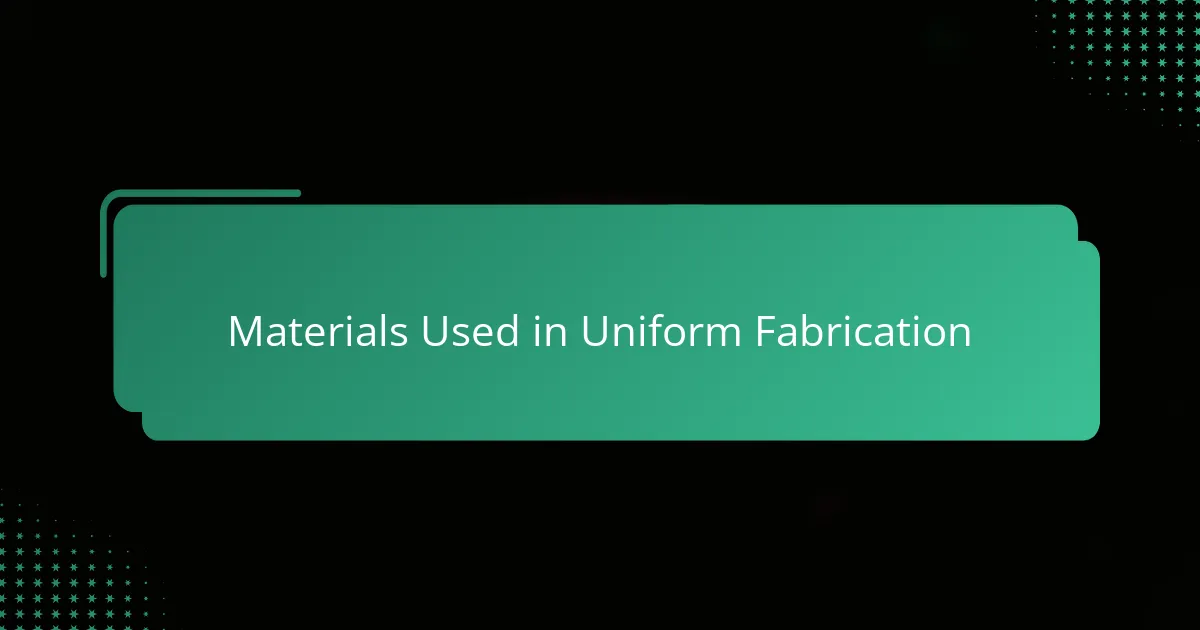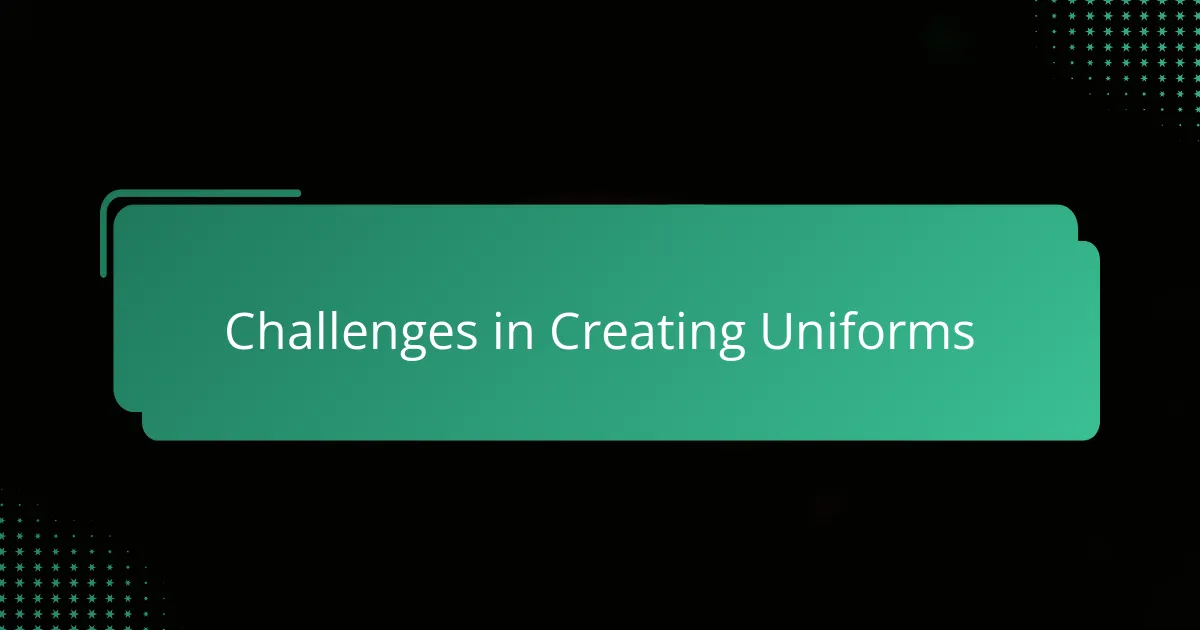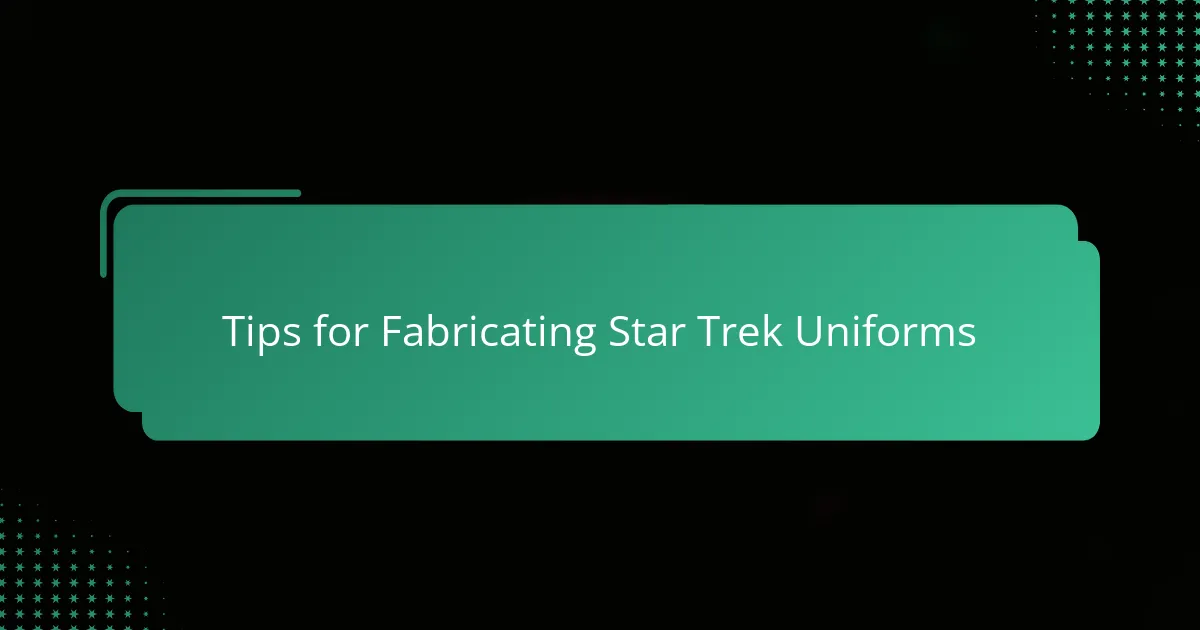Key takeaways
- Science fiction props, like Star Trek uniforms, are crafted with intentional design choices that enhance storytelling and create a sense of authenticity.
- Choosing the right materials is essential for capturing the unique look and feel of each Star Trek era, balancing aesthetics with wearability.
- Mastering sewing techniques and pattern-making is crucial for achieving accurate fits and authentic details in costume fabrication.
- Patience and meticulous attention to detail during the finishing stages are key to creating high-quality Star Trek uniforms that honor their legacy.

Understanding Science Fiction Props
Science fiction props have always fascinated me because they are more than just objects—they are gateways to entire universes. When I first held a replica of a Star Trek phaser, I felt a surge of connection to the stories and characters I admired, as if I was holding a piece of the future in my hands. Have you ever wondered how these props manage to evoke such vivid emotions despite being mere fabrications?
Understanding science fiction props means appreciating the blend of creativity and craftsmanship that brings imaginary worlds to life. Each piece, from sleek uniforms to intricate gadgets, embodies intentional design choices that reflect the culture and technology of its fictional universe. I find myself constantly amazed at how these details can spark such a strong sense of authenticity.
To me, the magic lies not just in the final product but in the process of creating these props. The passion behind assembling every stitch or molding every component reveals a deep respect for the stories we love. Isn’t it incredible how something so carefully crafted can transport us from reality into the realms of science fiction?

Overview of Star Trek Uniforms
Star Trek uniforms have always struck me as more than just costumes—they are visual storytellers that instantly convey rank, role, and personality. I remember watching the original series and being captivated by how a simple color-coded shirt could say so much without a single word. Isn’t it amazing how these designs blend functionality with symbolism?
Over the years, the uniforms evolved, reflecting shifts in both fashion and narrative tone. From the sleek, minimalist styles of The Next Generation to the textured and detailed fabric of Deep Space Nine, each iteration feels like a snapshot of its era. This progression shows how the creators remain attentive to both authenticity and innovation, engaging fans on multiple levels.
What intrigues me most is how these uniforms balance practicality with the imaginative needs of a sci-fi universe. Creating something that looks believable as futuristic workwear, yet still iconic enough to inspire cosplay and prop collectors, is no small feat. Have you ever thought about what goes into making those details feel real—right down to the texture of the fabric or the placement of insignias?

Materials Used in Uniform Fabrication
When I started fabricating Star Trek uniforms, choosing the right materials was a real game-changer for me. I found that synthetic fabrics like polyester blends work best because they mimic that sleek, slightly shiny look seen on screen, while also standing up to wear and tear from cosplay events. Have you ever tried sourcing fabric that looks good under stage lights but still feels comfortable? It’s trickier than I expected.
Another thing I learned is how texture plays a huge role in capturing the essence of each series. For example, the original series uniforms often used smoother, lighter-weight materials, which gave them that crisp, almost futuristic appearance. In contrast, Deep Space Nine’s textured wool-like fabric adds a depth that feels more tactile and grounded. This difference really shows how material choice affects the overall vibe of the uniform.
In my experience, finding the balance between authenticity and practicality means experimenting with stretch fabrics for fit and breathability. I remember testing several spandex blends to get that perfect contour without sacrificing freedom of movement. Isn’t it interesting how a uniform’s material can influence not just how it looks, but how it feels to wear—almost like stepping into a character’s shoes?

Techniques for Making Star Trek Uniforms
Fabricating Star Trek uniforms often starts with mastering precise sewing techniques, especially when working with stretchy or synthetic fabrics. I recall the first time I tackled the distinctive collar trim—it was a challenge to get the curves sharp and smooth, but the effort made the uniform truly come alive. Have you noticed how those small details can make or break the overall look?
Another technique I find essential is employing pattern-making that matches the original designs yet accommodates real-world fit. I’ve spent hours tweaking patterns to ensure that the uniforms hug the body just right, capturing that futuristic silhouette without feeling restrictive. Isn’t it fascinating how a slight adjustment in seam placement can transform a flat costume into something dynamic and wearable?
Lastly, finishing touches like precise embroidery for insignias or the use of heat-pressed logos add that layer of authenticity I value deeply. I remember the pride I felt the first time I attached a flawlessly sewn communicator badge—it’s those final details that connect the uniform to its Star Trek heritage. Don’t you think these embellishments are what truly make fans feel part of the universe?

Challenges in Creating Uniforms
One of the biggest challenges I faced was achieving the perfect fit for the uniforms while staying true to their iconic shapes. Stretch fabrics help, but tailoring synthetic materials can be tricky—I’ve often had to unpick seams multiple times to get the silhouette just right. Have you ever struggled to balance comfort and accuracy in costume design? That’s exactly what makes this process so demanding and rewarding.
Another hurdle is replicating the authentic look of the fabrics used in each Star Trek era. For example, capturing the subtle sheen of the original series’ shirts versus the textured layers of later designs requires not only the right materials but also skillful handling. I remember spending hours sourcing just the right thread and fabric combinations, realizing that even small mismatches can break the illusion for hardcore fans.
Beyond materials and fit, the intricate details like collar shapes, insignias, and trim placement demand exceptional precision. I once tried to recreate the distinctive collar piping and quickly learned that even a slight misalignment can throw off the whole uniform’s feel. These challenges often test my patience, but overcoming them is what makes fabricating these uniforms such a fulfilling artistic endeavor.

Personal Experiences with Fabrication
Working on my first Star Trek uniform felt like stepping into uncharted territory. I vividly remember the mix of excitement and frustration when the fabric didn’t behave as expected—stretching too much in one area while bunching awkwardly in another. Have you ever had a project where every stitch seemed to teach you something new? That experience taught me patience and the importance of trial and error.
There was one evening I stayed up late just to perfect the collar’s curve. It was tedious, but stitching that collar just right gave me a moment of pure satisfaction, as if I had bridged a tiny gap between fantasy and reality. I realized then that these small victories, though painstaking, make the entire process worthwhile.
Sometimes, I find myself reflecting on how tactile the experience is—pressing the fabric, adjusting seams, adding insignias. It’s not just about making a costume; it’s about honoring a legacy. Have you noticed how physical crafting can deepen your connection to a story you love? For me, each uniform is a conversation between the past and my hands.

Tips for Fabricating Star Trek Uniforms
One tip I’ve found invaluable is to invest time in creating or sourcing accurate patterns before cutting any fabric. Early on, I underestimated how much a well-fitting pattern shapes the final look—imagine the frustration of sewing a uniform only to realize the shoulders are too wide or the sleeves too long. Have you ever felt that moment when a small tweak in the pattern suddenly makes the whole uniform come to life? That’s the magic of careful preparation.
Another lesson from my experience is to use tailor’s chalk or water-soluble markers generously during construction. When working with dark, smooth fabrics typical of Star Trek uniforms, it’s easy to lose your place or misalign seams. Marking precisely where trims, insignias, or collars should sit saved me hours of agonizing seam ripping. Don’t you find that these little organizational tricks ultimately make the process feel more controlled and less stressful?
Lastly, I can’t emphasize enough the importance of patience during the finishing stages. Attaching embroidered badges or heat-pressed logos might seem straightforward, but I’ve learned they require steady hands and an eye for detail to avoid wrinkles or uneven placement. Remember how satisfying it felt the first time you nailed those final touches perfectly? Those moments remind me that the effort invested is what truly honors the Star Trek legacy I cherish.


